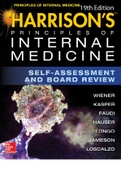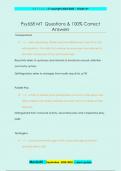PRINCIPLES OF INTERNAL MEDICINE
19th Edition
‘HAISON’S P L E 8
IN T 0E H N A0L
M E D | C | N E
SELF-ASSESSMENT
AND BOARD REVIEW
WIENER
KASPER
'
h Ml:
Graw
' . Hill
. Education
LOSCALZO
, SECTION I
General Considerations in Clinical Medicine
QUESTIONS
DIRECTIONS: Choose the one best response to each question.
I-1. All of the following statements regarding practice guidelines set forth by governing agencies and
professional organizations are true EXCEPT:
A. Clinical practice guidelines protect caregivers against inappropriate charges of malpractice, yet
do not provide protection for patients from receiving substandard care.
B. Practice guidelines have largely reached a stage of nuance allowing them to address every unique
illness and patient presented to the modern physician.
C. Practice guidelines provide a legal constraint to physicians, and deviation from guideline-based
care invariably leaves physicians vulnerable to legal action.
D. Where different organizations disagree regarding practice guidelines, a third-party agency has
been appointed to mitigate these disagreements such that now all major organizations’ guidelines
are consistent.
E. All of the above statements are not true.
I-2. Regarding molecular medicine, which of the following statements represents an INACCURATE
example of the listed area of study:
A. Exposomics: An endocrinologist studies sunlight exposure and population risk of hip fracture.
B. Metabolomics: A biochemist studies the rate of flux through the creatine kinase pathway during
the cardiac cycle.
C. Metagenomics: A biologist studies the genomic alterations in molds commonly found in human
dwellings.
D. Microbiomics: A microbiologist studies the genomic variation in thermophiles, bacteria that can
survive extreme heat near deep ocean vents.
E. Proteomics: A cardiologist studies desmosomal proteins and their posttranslational modifications
in studying arrhythmogenic right ventricular dysplasia.
I-3. Which of the following is the best definition of evidence-based medicine?
A. A summary of existing data from existing clinical trials with a critical methodologic review and
statistical analysis of summative data
B. A type of research that compares the results of one approach to treating disease with another
approach to treating the same disease
C. Clinical decision-making support tools developed by professional organizations that include
expert opinions and data from clinical trials
D. Clinical decision making supported by data, preferably randomized controlled clinical trials
E. One physician’s clinical experience in caring for multiple patients with a specific disorder over
many years
,I-4. Which of the following is the standard measure for determining the impact of a health condition on
a population?
A. Disability-adjusted life-years
B. Infant mortality
C. Life expectancy
D. Standardized mortality ratio
E. Years of life lost
I-5. Which of the following statements regarding disease patterns worldwide is true?
A. Childhood undernutrition is the leading risk factor for global disease burden.
B. In a 2006 publication, the World Health Organization (WHO) estimated that 10% of the total
global burden of disease was due to modifiable environmental risk factors.
C. In 2010, ischemic heart disease was the leading cause of death among adults.
D. In the last two decades, mortality attributed to communicable diseases, maternal and perinatal
conditions, and nutritional deficiencies has remained fairly stable, with the majority (76%) of
mortality from these causes occurring in sub-Saharan Africa and southern Asia.
E. While poverty status has been shown to be linked to health status on the individual level, the
same relationship does not hold true when studying the link between national health indicators
and gross domestic product per capita among nations.
I-6. You are appointed to a governmental healthcare advisory subcommittee concerned with addressing
problems facing the global health community. Your task is to draw general conclusions from the
global fight against tuberculosis (TB) and human immunodeficiency virus (HIV)/acquired
immunodeficiency syndrome (AIDS) that may be applied in combatting other diseases, including
noncommunicable diseases. Which of the following conclusions is reasonable when considering
HIV/AIDS and TB as chronic diseases?
A. Barriers to adequate healthcare and patient adherence imposed by extreme poverty must be
concomitantly addressed to adequately treat and prevent chronic disease in developing nations.
B. Charging small fees for health services (e.g., AIDS prevention and care) supplies the patient with
a sense of the treatment’s value and increases compliance and overall public health.
C. Despite adequate available tools to practice their trade locally in developing nations, many
physicians and nurses emigrate to developed nations to practice their respective trades, a
phenomenon called “brain drain.”
D. In developed nations where physicians are abundant, community health worker supervision of
the care of chronically ill patients is not effective.
E. In the case of chronic infectious diseases, switching from one drug to another through a
prolonged course of treatment provides the highest cure rate by obviating the infectious agent’s
ability to develop resistance to any single drug.
I-7. Mrs. Jones, a 22-year-old African American woman, presents to Dr. Smith, an internal medicine
specialist, with a facial rash. Mrs. Jones states that the rash began after spending a day at the beach
with her family. She also notes that her metacarpophalangeal and proximal interphalangeal joints
have been painful and swollen for the preceding 2 weeks. On examination, the joints are swollen and
tender. Laboratory analysis discloses reduced creatinine clearance, proteinuria, and hemolytic
anemia. Antinuclear antibodies (a test with a high negative predictive value for systemic lupus
erythematosus) are detected at significant titer, and ultimately, the diagnosis of systemic lupus
erythematosus is made.
Two weeks later, Mrs. Johnson, a 24-year-old African American woman, presents with a facial rash
and elbow pain to Dr. Smith. After a cursory interview and brief physical exam, Dr. Smith sends
blood work only testing for antinuclear antibodies. When the test returns negative (no antibodies
detected), Dr. Smith presumes this to be a false-negative result and starts Mrs. Johnson on
hydroxychloroquine and prednisone for treatment of systemic lupus erythematosus. Which
heuristic(s) did Dr. Smith likely employ in diagnosing Mrs. Johnson with systemic lupus
erythematosus?
, A. Availability heuristic
B. Anchoring heuristic
C. Bayes’ rule
D. Confirmation bias
E. A and B
I-8. You have invented a blood test, which you name “veritangin,” to determine if patients are having a
myocardial infarction. You devise an experiment to determine the performance of your veritangin
assay by testing it versus the troponin assay, the currently accepted gold standard for determining
myocardial infarction, in 100 random emergency department patients with chest pain. You choose a
veritangin result >1 ng/dL as positive for myocardial infarction. Your results are listed in the table
below.
Which of the following statements regarding the characteristics of the veritangin assay in this trial is
true?
A. The posttest probability of the veritangin test does not depend on the population studied.
B. The sensitivity of the veritangin assay depends on the population studied and the disease
prevalence in that population.
C. The sensitivity of the veritangin assay will decrease by 50% if you reduce the threshold for a
positive result to >0.5 ng/dL.
D. The sensitivity of the veritangin test cannot be calculated based on the above data.
E. The specificity of the veritangin assay is 0.93 (70/75).
I-9. You are designing a clinical trial to test the use of a novel anticoagulant, clotbegone, in the
treatment of deep vein thrombosis. Which of the following statements regarding the design of the
trial is true?
A. An optimal study design would assign many patients to clotbegone and compare their outcomes
to the outcomes of prior (historical) patients not taking clotbegone. This would allow faster trial
completion.
B. If the trial returns a positive result (clotbegone is superior to placebo), that means that any
patient with a clot would benefit from clotbegone therapy.
C. Observing the outcomes of patients already taking clotbegone versus patients who are not is
preferable to assigning patients to clotbegone or placebo in a blinded fashion. The observational
strategy is more “real world,” applicable to the general population, and free of bias.
D. Population selection for the trial enrollment is not important as long as careful attention to
randomization and blinding is observed.
E. The advantage of performing a randomized clinical trial of clotbegone over a prospective
observational study of clotbegone is the avoidance of treatment selection bias.
I-10. A receiver operating characteristic (ROC) curve is constructed for a new test developed to diagnose
disease X. All of the following statements regarding the ROC curve are true EXCEPT:
A. One criticism of the ROC curve is that it is developed for testing only one test or clinical
parameter with exclusion of other potentially relevant data.
B. ROC curve allows the selection of a threshold value for a test that yields the best sensitivity with
the fewest false-positive tests.





